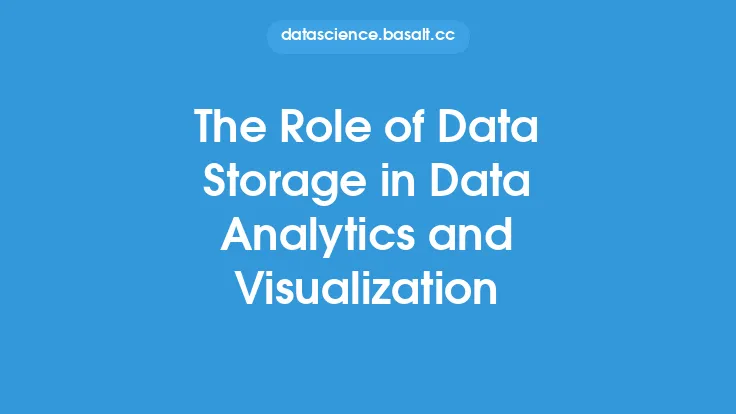As machine learning and artificial intelligence (AI) continue to transform industries and revolutionize the way we live and work, the importance of data storage in supporting these workloads cannot be overstated. Machine learning and AI algorithms rely heavily on large amounts of high-quality data to learn, train, and make predictions or decisions. However, the sheer volume, variety, and velocity of this data pose significant challenges for data storage systems. In this article, we will delve into the key considerations for data storage in machine learning and AI workloads, exploring the technical requirements, storage architectures, and best practices for optimizing data storage in these environments.
Introduction to Machine Learning and AI Data Storage
Machine learning and AI workloads involve the processing and analysis of vast amounts of data, including structured, unstructured, and semi-structured data. This data can come from various sources, such as sensors, social media, databases, and files. The data storage system must be able to handle the high throughput and low latency required for real-time data processing, as well as provide scalable and flexible storage capacity to accommodate the growing amounts of data. Furthermore, the storage system must ensure data integrity, security, and reliability, as machine learning and AI algorithms are only as good as the data they are trained on.
Technical Requirements for Machine Learning and AI Data Storage
The technical requirements for data storage in machine learning and AI workloads are unique and demanding. Some of the key requirements include:
- High-performance storage: Machine learning and AI workloads require fast storage systems that can handle high-throughput and low-latency data access. This is particularly important for applications such as real-time image and speech recognition, natural language processing, and predictive analytics.
- Scalability: The storage system must be able to scale to accommodate growing amounts of data, as well as handle increasing numbers of users and applications.
- Flexibility: The storage system must be able to handle a variety of data formats and types, including structured, unstructured, and semi-structured data.
- Data protection: The storage system must provide robust data protection mechanisms, such as backup, replication, and disaster recovery, to ensure data integrity and availability.
- Security: The storage system must provide robust security mechanisms, such as encryption, access control, and authentication, to protect sensitive data from unauthorized access.
Storage Architectures for Machine Learning and AI Workloads
There are several storage architectures that can be used to support machine learning and AI workloads, including:
- Distributed storage systems: These systems use a network of storage devices to provide scalable and flexible storage capacity. Examples include Hadoop Distributed File System (HDFS), Ceph, and Gluster.
- Object storage systems: These systems store data as objects, which can be accessed and manipulated using APIs. Examples include Amazon S3, OpenStack Swift, and Ceph Object Gateway.
- Block storage systems: These systems store data as blocks, which can be accessed and manipulated using block-based protocols such as iSCSI and Fibre Channel. Examples include SAN (Storage Area Network) and DAS (Direct-Attached Storage).
- File systems: These systems store data as files, which can be accessed and manipulated using file-based protocols such as NFS and SMB. Examples include NAS (Network-Attached Storage) and local file systems.
Best Practices for Optimizing Data Storage in Machine Learning and AI Workloads
To optimize data storage in machine learning and AI workloads, several best practices can be followed:
- Use a scalable and flexible storage architecture that can handle growing amounts of data and increasing numbers of users and applications.
- Use high-performance storage systems that can handle high-throughput and low-latency data access.
- Use data compression and deduplication to reduce storage capacity requirements and improve data transfer efficiency.
- Use data protection mechanisms, such as backup, replication, and disaster recovery, to ensure data integrity and availability.
- Use security mechanisms, such as encryption, access control, and authentication, to protect sensitive data from unauthorized access.
- Monitor and analyze storage system performance to identify bottlenecks and optimize storage configuration.
Data Storage Considerations for Deep Learning Workloads
Deep learning workloads, such as those used in image and speech recognition, natural language processing, and predictive analytics, have unique data storage requirements. Some of the key considerations include:
- High-performance storage: Deep learning workloads require fast storage systems that can handle high-throughput and low-latency data access.
- Large storage capacity: Deep learning workloads require large amounts of storage capacity to accommodate the vast amounts of data used for training and testing.
- Low-latency data access: Deep learning workloads require low-latency data access to ensure fast data processing and analysis.
- Scalability: Deep learning workloads require scalable storage systems that can handle growing amounts of data and increasing numbers of users and applications.
Data Storage Considerations for Real-Time Analytics Workloads
Real-time analytics workloads, such as those used in streaming data processing and event-driven architectures, have unique data storage requirements. Some of the key considerations include:
- High-performance storage: Real-time analytics workloads require fast storage systems that can handle high-throughput and low-latency data access.
- Low-latency data access: Real-time analytics workloads require low-latency data access to ensure fast data processing and analysis.
- Scalability: Real-time analytics workloads require scalable storage systems that can handle growing amounts of data and increasing numbers of users and applications.
- Data freshness: Real-time analytics workloads require fresh data to ensure accurate and timely insights.
Conclusion
In conclusion, data storage plays a critical role in supporting machine learning and AI workloads. The technical requirements, storage architectures, and best practices for optimizing data storage in these environments are unique and demanding. By understanding these requirements and using the right storage architectures and best practices, organizations can ensure that their machine learning and AI workloads are supported by fast, scalable, and reliable data storage systems. As machine learning and AI continue to evolve and transform industries, the importance of data storage in supporting these workloads will only continue to grow.





